
Lomatium is a genus of about 75 species of perennial herbs native to western North America; its common names include biscuitroot, Indian parsley, and desert parsley. It is in the family Apiaceae and therefore related to many familiar edible species such as carrots and celery; some Lomatium species are extensively used by Native Americans in the inland Northwest as a staple food.
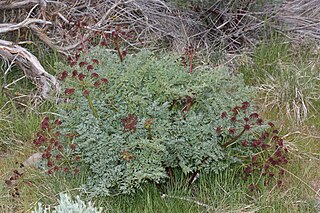
Lomatium dissectum is a species of flowering plant in the carrot family known by the common names fernleaf biscuitroot and fernleaf desert parsley. It is native to much of western North America, where it grows in varied habitat. It is found in the eastern slopes of the Cascade Range, Rocky Mountains, Klamath Mountains, eastern Transverse Ranges and the Sierra Nevada in California.
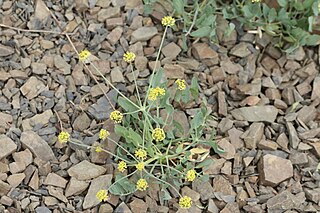
Lomatium nudicaule is a species of flowering plant in the carrot family known by the common names pestle lomatium, barestem biscuitroot, Indian celery and Indian consumption plant. It is native to western North America from British Columbia to California to Utah, where it is known from several habitat types, including forest and woodland. It is a perennial herb growing up to about 70 centimetres (28 in) tall from a thick taproot. It generally lacks a stem, the inflorescence and leaves emerging from ground level. The leaves are made up of many dull green, waxy lance-shaped leaflets each up to 9 cm long. The inflorescence is borne on a stout, leafless peduncle widening at the top where it blooms in an umbel of yellow or purplish flowers.

Leptospermum laevigatum, commonly known as the coast tea tree, is a species of shrub or small tree that is endemic to south-eastern Australia, but has been widely introduced in other places where it is often considered to be a weed. It has thin, rough bark on the older stems, narrow egg-shaped leaves, relatively large white flowers and flat topped fruit that is shed shortly after reaching maturity.
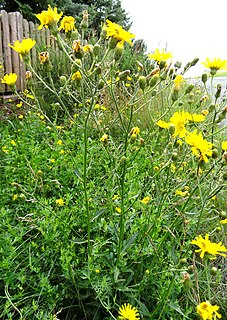
Hieracium laevigatum, or smooth hawkweed, is a Eurasian plant species in the tribe Cichorieae within the family Asteraceae. It is widespread across much of Europe and western Asia. It is very similar to Hieracium sabaudum and can be found on dry, more or less nutrient rich soil in light woods, grassy embankments and fields, or on walls.
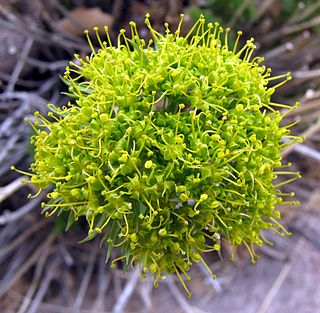
Lomatium parryi, commonly known as Parry's biscuitroot and Utah desertparsley, is a perennial herb in the carrot family. It is a common herb in high altitude areas of deserts and common in desert National parks, such as Death Valley mountains, in the western part of the United States.

Lomatium bradshawii, also known as Bradshaw's desert parsley, is an endangered perennial herb native to Oregon and Washington, United States. Lomatium bradshawii was thought to be extinct until 1979, when it was rediscovered by a University of Oregon graduate. This herb was common in the Willamette Valley before agricultural development and fire prevention which has allowed shrubs and weeds to invade. Most known populations of Lomatium bradshawii are within ten miles of Eugene, Oregon. In the Willamette Valley, populations exist in the Oregon counties Lane, Benton, Linn, and Marion, and in Washington Lomatium bradshawii grows in Puget Sound. The largest population of this herb is in Camas Meadows, Washington, with a population of 10,7900,00 +/- 2,010,000, and the Berry Botanic Garden keeps a seedbank.
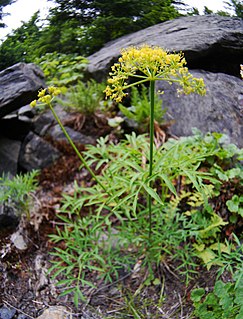
Lomatium brandegeei, also known as Brandegee's desert-parsley is a perennial herb of the family Apiaceae that grows in northern Washington and into British Columbia. Compound umbels with yellow flowers appear from May to June. It has a relatively short taproot, and its stems are 20–60 cm tall.

Lomatium canbyi is a species of flowering plant in the carrot family known by the common name Canby's biscuitroot. It is native to the Pacific Northwest of the United States and northeast California, where it grows in sagebrush-covered plateau habitat and barren flats.

Lomatium columbianum is a perennial herb of the family Apiaceae known by the common names purple leptotaenia and Columbia desert parsley. It is endemic to the U.S. states of Oregon and Washington, mostly along the Columbia River east of the Cascades.

Lomatium cuspidatum is a perennial herb of the family Apiaceae, native in the U.S. state of Washington. It is found primarily on open rocky slopes in the Wenatchee Mountains, often associated with serpentine soils.
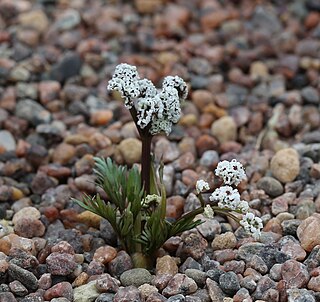
Lomatium gormanii, with the common names Gorman's biscuitroot and salt & pepper, is a perennial herb of the family Apiaceae. It is endemic to the Northwestern United States, in Idaho, Oregon, and Washington, being found in steppes and montane environments. It is called sasamít̓a, sasamít̓aya, and łałamít̓a in the Sahaptin language.

Lomatium grayi, commonly known as Gray's biscuitroot, Gray's desert parsley, or pungent desert parsley, is a perennial herb of the family Apiaceae. It is native to Western Canada in British Columbia, and the Western United States, including from the Eastern Cascades and northeastern California to the Rocky Mountains.

Lomatium suksdorfii is a perennial herb of the family Apiaceae that grows in Washington and Oregon, United States.
Lomatium marginatum is a species of flowering plant in the carrot family known by the common name butte desertparsley. It is endemic to California, where it is known from mountains, valley, and grassland habitat, including serpentine, in the northern half of the state. It is a perennial herb growing up to about half a meter tall from a small taproot. There is no stem, and the leaves and inflorescence emerge from ground level. The purple-green leaves may approach 30 centimeters long, their blades divided into many long, narrow segments. The short but wide inflorescence bears an umbel of yellowish, purplish, or reddish flowers. The Lomatium marginatum is not currently an endangered species.

Limnobium laevigatum is a floating aquatic plant, and is a member of the family Hydrocharitaceae. Common names include West Indian spongeplant, South American spongeplant and Amazon or smooth frogbit. This plant was introduced to North American waterways through use in aquariums and aquascapes.
Sparganothis tunicana is a species of moth of the family Tortricidae. It is found in North America in California, Washington, Oregon, Utah, Idaho and British Columbia.
Depressaria betina is a moth in the family Depressariidae. It was described by John Frederick Gates Clarke in 1947. It is found in North America, where it has been recorded from California to Washington.
Depressaria togata is a moth in the family Depressariidae. It was described by Lord Walsingham in 1889. It is found in North America, where it has been recorded from Montana, from British Columbia to Arizona and in Oregon and Washington.
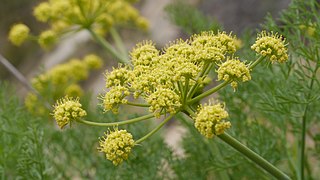
Lomatium thompsonii, commonly known as Thompson's desertparsley, is a perennial herb of the family Apiaceae endemic to Chelan and Kittitas County in Washington, United States. It grows in open, rocky slopes and pine forests. Flowers bloom May to June.
















